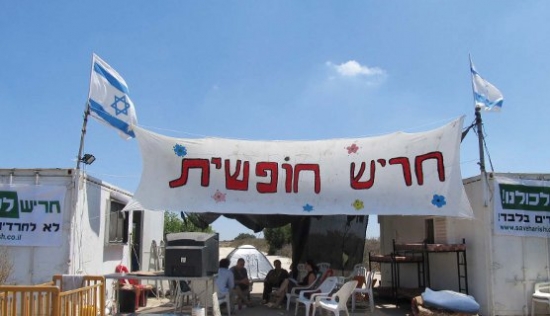
Text & Photograph: Lydia Aisenberg
Tel Avivians Tony Benjamin and Roni Acker moved from the city which never stops, to the out-of-the way, almost permanently sleepy Israeli community of Harish on the lip of the Dotan Valley, close to Wadi Ara.
They were attracted to the area because of the off-the-beaten-track location surrounded by undulating hills and valley floor covered in natural forests, and home to a rich and diverse fauna, flora and wildlife population.
“This area is pretty unique as it is, situated between the Mediterranean coastline and the mountain ranges of Menashe, Amir and Shomron, forming a natural ecological basin of geological and topographical importance,” explains Tony, an artist specializing in conservation of concrete decorative tiles and balustrades, verandas and art-deco found in the Bauhaus buildings of Tel Aviv.
Five years down the line Tony and Roni are fighting to save the surrounding forests, plants and wildlife habitats about to be destroyed in order to build a city for ultra-orthodox families who can no longer find housing in Jerusalem, Beit Shemesh, Bnei Brak and other religious towns in the center of the country.
Founded in the late 1980s in an attempt to attract more Israelis to live close to the pre-1967 border with Jordan, Harish is one of seven communities built along the Green Line and known as the Seven Stars of Sharon, Ariel Sharon having been the Minister of Housing and Infrastructure when the decision to construct the communities was made.
Israelis did not exactly rush to snap up the bargain-priced apartments and few rows of small, two-up-two-down ‘cottages’, as the homes are not only in a somewhat isolated area, but they are also within hearing distance of the muezzin calling out to the faithful in nearby Israeli Arab villages and, a short distance away, over the Green Line and a security fence, a cluster of large and small Palestinian villages.
Never getting off the ground in the same way as the other six-star communities, Harish has an unusual makeup of residents - the majority are immigrants from the Caucasus region of the former Soviet Union, brought to Harish directly from Ben Gurion airport, who have been struggling to make a living and to make ends meet ever since; a group of twenty Jewish families who are Hari Krishna devotees; a number of Arab families who had to leave the town of Ramle because of deadly feuding with another extended Arab family; a small community of modern orthodox people who made Harish their home in recent years as well as relative newcomers on the Harish block - a group of Breslov families. They form a kaleidoscope of Israeli society which will be totally swamped should the government develop Harish into a city for 150,000 Haredim.
A housing solution for the modern orthodox families has already been found. They are due to move to the town of Pardes Hanna on the other side of the Wadi Ara highway. The Breslov families say they will have to move elsewhere when the Haredim move in. On this point Tony cites the controversies surrounding the rocky relations between various religious communities in the town of Beit Shemesh. However, “absolutely nothing has been said about the home-owners who have lived in Harish for 15 years,” says Tony who rents with his partner Roni. Initially they wanted to buy in Harish but decided to first rent, a decision they certainly do not regret these days.
“It goes beyond belief that there is an intention to destroy an area of natural beauty such as this,” exclaims Tony, spreading his arms as if to incorporate all Mother Nature’s spring finery for miles around.
“The area to be bulldozed to the ground to create this new city is equivalent to the area that was burnt out by the catastrophic Carmel blaze,” explains Roni, disbelief written across his face.
A dealer in artifacts and antiques, especially from the 1950s and 60s, Roni is also a photographer. The artist and the photographer have been waging a struggle against the intended destruction of what is their backyard, courtyard and approach to home, by putting their natural talents to canvas and recording through photography what is about to come under the bulldozers of the Housing and Construction Ministry.
“Originally Harish was planned as a town for 30,000 people and there is an existing infrastructure to cater for that number of people,” explains Tony as we pass by a water hydrant almost hidden from view by a tree that has regrown after having been cut down initially to make way for the water system. As we walk down the well-trodden hikers' path, a rock formation in the middle sports surveyors’ markings - in black numbers and letters, the planners have left their stark mark ‘O 4024 GB’.
The intended controversial destruction and construction in Harish has ignited both Jews and Arabs living in the Wadi Ara-Dotan Valley vicinity, and court cases have been initiated by Green groups such as Adam, Teva V’Din (Israel Union for Environment Defense) and groups of concerned citizens.
Jewish and Arab Israeli residents of Wadi Ara have demonstrated together in an attempt to stop the government plans to engulf them in a concrete jungle, regardless of who the residents will be, although they are also deeply concerned about such a large ultra-orthodox population becoming the majority in an area of predominantly Arab Muslims and secular Jews living in Harish, as well as in the Hashomer Hatzair movement’s kibbutzim of Barkai, Ma’anit and Metzer – all within walking distance of the present day 300 Harish households - roughly 1,200 adults and children.
“We have always had a good relationship with our Arab neighbors, especially those of Umm al-Kutuf over there,” says Roni, pointing to large houses and a golden domed mosque with high minaret built atop two hills overlooking Harish and the expanse of greenery down below. “Since the plan was published we have found even more areas of commonality, feeling equally strongly about the destruction of oak and olive trees that are hundreds of years old. Our Arab neighbors have told us that their grandparents fought to keep those trees from being destroyed and now, together, we will continue that struggle in the name of the past and the present and our joint futures.”
Not all the people in Harish are out demonstrating or are willing to talk about the issue. There are those who are waiting for the day the construction begins and the value of their more than modest homes rockets skywards as families want to buy in. One resident, who wishes to remain nameless, admits this is the case for her. “We have already been told that the secular among us are expected to feel the squeeze, and in the name of the local head of the council who was given the job of overseeing the municipality when it went broke, that those of us who don’t want to live a religious lifestyle should leave.”
When this was mentioned to Tony and Roni they again used Beit Shemesh as an example of what could well be awaiting those who think they are going to cash in on the drastic changes in the local demography. “In Beit Shemesh, many of the original homeowners still remain as they simply cannot afford to buy decent homes elsewhere, and why should it be different in Harish when the time comes?” they say.
“Construction in Harish was subsidized and the land is free. There are also monetary benefits specifically for large families.”
So, how come there aren’t thousands of Israelis out there demonstrating not to tear down such a large green lung in the already overcrowded center of the country?
“Most people - even some of those living relatively close by, do not realize how large an area the Housing Ministry plans to take over in order to create this new city. It is not apathy, but rather ignorance of the uniqueness of the area, as the majority of Israelis have never visited Harish or its environs and do not realize what a disaster is in the making if the government and local municipalities allow this plan to be carried out,” says Tony, the painting on his easel showing in oils, the trees, rock formations and Palestinian village of Anin in the near distance which are likely, except for the latter, to be swallowed up and replaced by a concrete jungle if the Housing Minister sees his plans for the area come to fruition.
Talking and walking with Tony and Roni along the narrow pathways between hundreds of trees, bushes, thick undergrowth and open areas where an abundance of stunning varieties of multicolored wild flowers stand proudly, one cannot but think how ridiculous it is that Israel asks communities abroad to donate money to plant trees in the state whilst it is about to destroy those that are already deeply rooted in the country.

Local artist Toni Benjamin has been painting the forest that is threatened by the building of the housing for the Haredim.
 End of Year Event - Hefzibah, Netanya
End of Year Event - Hefzibah, Netanya Additional 1-time Payment to Survivors who worked in the Ghetto
Additional 1-time Payment to Survivors who worked in the Ghetto ITAMAR MAKES FRIENDS - A Review
ITAMAR MAKES FRIENDS - A Review From Australia with Love
From Australia with Love Monkey Tales
Monkey Tales A fresh spirit of Zionism from Manhattan
A fresh spirit of Zionism from Manhattan Lydia Aisenberg
Lydia Aisenberg